Getting the ‘right people on the bus‘, as business guru Jim Collins put it, is everything. The Moving Company‘s choice of truck – and driver for that matter – for their fast-turn container operations is proving they‘ve certainly got the right MAN for the job.
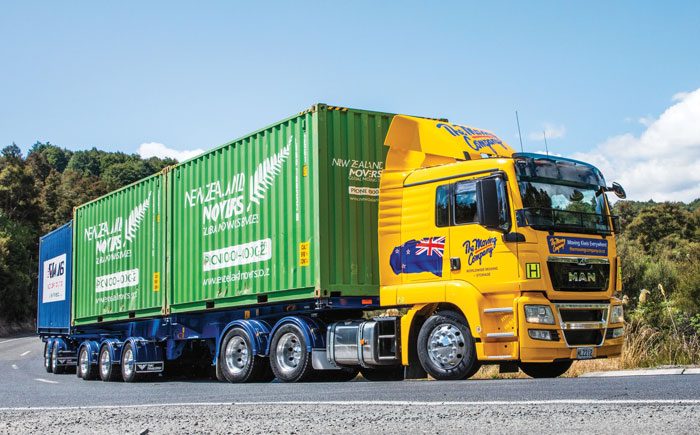
Hollywood will have you believe that a special ops soldier should be tall, square-jawed, and look ‘built‘, a.k.a. Schwarzenegger or Stallone. Talk to a military specialist however, and they‘ll likely roll their eyes. When it comes to elite roles like the SAS, they tend to keep an eye out for the smaller framed sinewy types, with strength disproportionate to their size, stamina to burn, and not a lot of mass to keep alive when food is short and the canteen is dusty on the inside. We all know the type, the ones still chucking ‘idiot bricks‘ five high on the hay trailer when the local rugby club tight-head prop is asleep in the corner of the hay barn after complaining of a sore back.
Meet Richard Seeley, a 57-year-old trucker who has done – wait for it – 41 years on furniture. Richard is one of ‘those‘ guys. Small in stature, wiry, with no off-switch … oh, and a thorough gentleman to boot. Now meet his truck, the four-month-old MAN 26.440 TGS 6×4 tractor with a 5-axle TMC skeletal B-train that he drives for The Moving Company. And don‘t be mistaken, this unit is no golden triangle container relocator, this is the real deal! That striking yellow MAN you saw in Auckland on Monday, and then again in Invercargill on Thursday? It‘s the same one buddy, there ain‘t two!
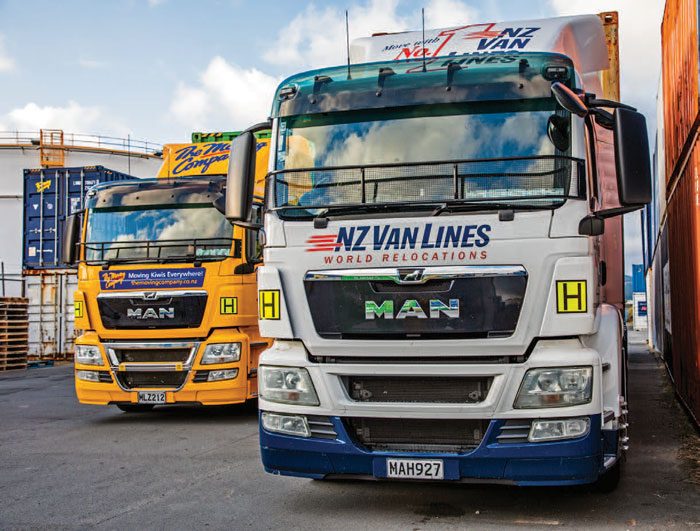
…and there‘s not just one…
Well, there is, but there‘s not. The Moving Company has some furniture moving and storage siblings in NZ Van Lines, New Zealand Movers, and Ausmove. NZ Van Lines is surely one of the country‘s more iconic trucking liveries, and they have a sister combination to Richard‘s, with a year‘s service under its wheels and driven by Glenn Herlihy. Both units are identical in spec, configuration, and work profile. “You‘ve struck it lucky,” said group logistics manager Peter Cochrane. “They never run together, but right on the days you‘ll be with them they‘re on the same ferry and will be in synch for a couple of days. You‘ll be able to get pics of the two together.” (Thanks Murph)
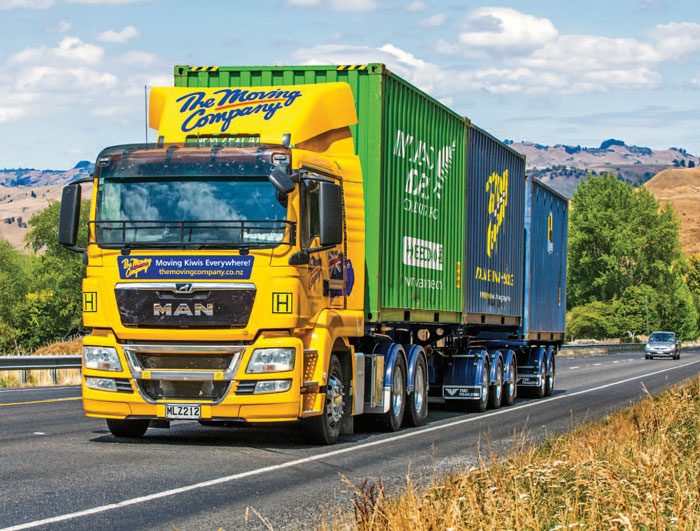
Photo: Richard Storms up the Taihape deviation on the first day of our outing.
First impressions
We met Richard on the side of the road in Waiouru. Having teed the test up with the incredibly obliging Peter, we had a suspicion it was going to be a great couple of days. Thirty seconds after meeting Richard we were in absolutely no doubt. Neil Powell in Graham Redington‘s T659 Kenworth was parked alongside the MAN having his half-hour break. He jumped out to see what was going on, and to put it bluntly, if someone had arrived at that point with five deck chairs, a sun brolly, and a chilly full of coldies, we‘d have likely still been there, such was the convivial scene. But there was work to be done and an MAN to have a closer look at, so off we all went. There‘s no questioning the effectiveness of striking presentation. The truth is, 99% of us are still primal critters first and looks count; we‘re drawn to nice, non-threatening things. In that context The Moving Company has done a firstrate job. The MAN‘s bright yellow livery with the nation‘s flag flying proudly on the flanks and air-kit looks fantastic, and the cursive script that‘s used for the company name looks friendly and inviting. The MAN is a head-turner, and of course if you approached the chap repping the brand behind the wheel, you‘d happily chuck your beloved piano or Ming coffee mugs in the back and wave goodbye.
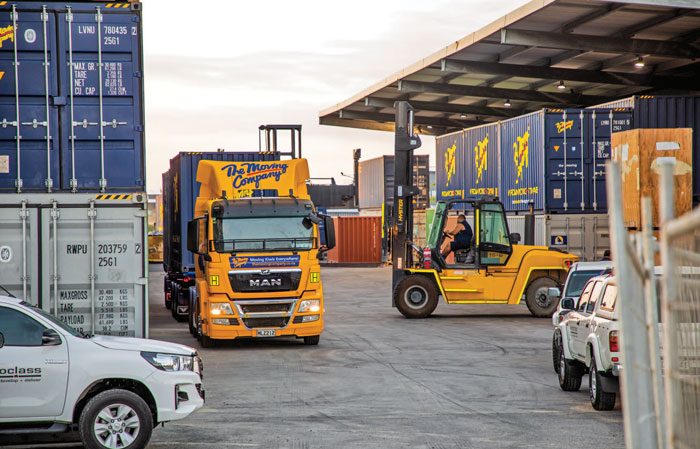
Photo: Turn and burn! Richard‘s stay in the big smoke can be as short as an hour and a bit!
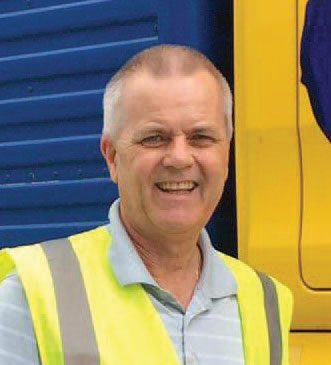 Photo: Peter Cochrane, group logistics manager at The Moving Company oozes the company culture of friendly ‘doers‘
Photo: Peter Cochrane, group logistics manager at The Moving Company oozes the company culture of friendly ‘doers‘
Furniture … 21st century style
“They‘re bloody hard to keep up with sometimes,” said Peter. “They just cover the work so quickly. It seems they‘ve barely left for the other end of the country and all of a sudden Richard or Glenn are hovering around again. It‘s a new challenge for the schedulers in Wellington keeping the MANs fed. They have to think well ahead.” What Peter‘s describing is the fast-turn furniture operation the two companies operate with the MANs. In the 21st century it‘s not just international furniture that moves around in specialist 20-foot high cube containers, domestic does as well. While there‘s still a good number of traditional style big-bodied furniture trucks in the greater fleet, furniture moving today is ever more modular.
House lots can be packed into furniture containers, sealed, and then taken to wherever they need to go – three house lots at a time with the wonders of HPMV. The MANs and TMC B-trains were built especially for the linehaul legs of ‘modulisation‘, able to take three 20-foot containers, or one 20 and a 40. The average payload on Richard‘s unit is about 20 to 22 tonne including the box, giving him an all-up of about 35,840 to 36,840kg. With its 328kW (440hp) engine, that gives the MAN a power to weight ratio of 8.8kW/tonne (11.8hp/tonne), which is line-ball with a 448kW (600hp) truck at 50MAX.
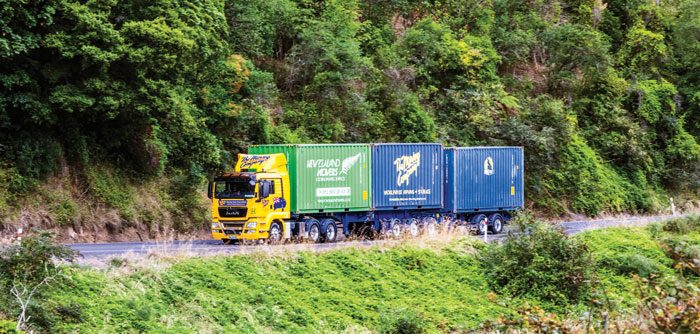
Photo: The striking yellow MAN descending the Piriaka Saddle.
MANatomy
Under the MAN‘s bright cab is the company 10.5-litre D2066LF40 Euro 5 motor. It‘s a 6-cylinder engine with four valves per cylinder and common rail injection, turbo and intercooling obviously, and electronic regulation. The emissions standard is achieved via SCR. Power peak as we said is 328kW (440hp) and that occurs between 1600 and 1900rpm, while torque peaks at 2100Nm (1550lb/ft) from 1000 to 1400rpm. Again, it‘s a typical profile for a motor of this genre, with the peaks not quite meeting, although power is just a Lion‘s whisker (10kW) off its top number at peak torque.
Behind the engine is MAN‘s 12-speed TipMatic – which as we know is an MAN-finessed ZF AS-Tronic – with electropneumatic shifting and clutch, meaning she‘s a two-pedal jobbie. The front axle is MAN‘s VOK-07 dropped front axle (there are high ground clearance options) at 7.5 tonne rating, riding on parabolic leaf springs and shock absorbers with a stabiliser. In the rear, MAN HYD-1370/1350 hypoid axles at 3.08:1 with diff lock and rated at 23 tonne ride on MAN 8-bag ECAS (Electronically Controlled Air Suspension), again with stabilisers.
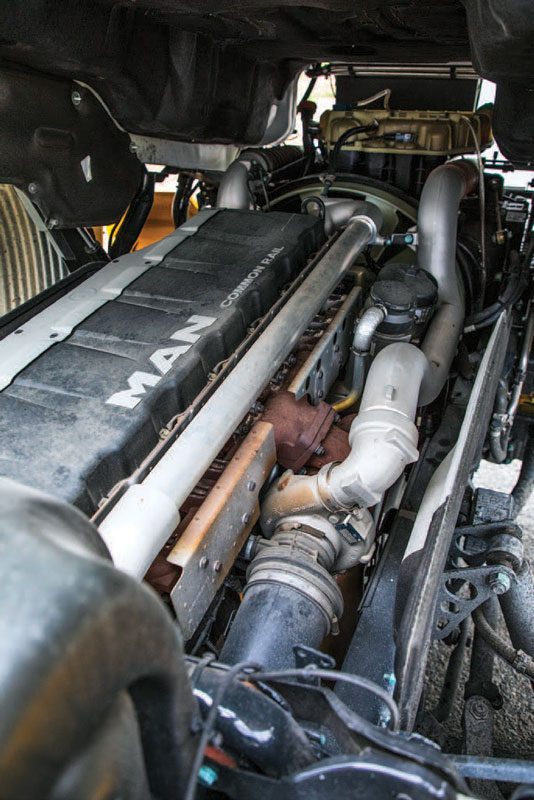 Photo: 440hp, 2020 style. The 10.5-litre D20 motor.
Photo: 440hp, 2020 style. The 10.5-litre D20 motor.
Braking is disc on the tractor (drum on the trailers), with EBS/ABS, ESC, ASR. In terms of auxiliary braking the truck sports the proprietary EVBec (exhaust Valve Brake electronically controlled). That‘s MAN‘s snazzy impetus inhibitor with the exhaust flap upstream of the turbo, directing a proportion of released gas to the turbo veins, increasing speed, therefore induction, therefore back pressure… therefore braking. All in all it‘s a contemporary spec for a modern truck that will likely be here for another year or more. Trailer wise, the B-train hails from that Hall of Fame bastion of Kiwi innovation, Christchurch‘s own TMC. A 5-axle 40/20 unit, it‘s a classic skeletal set up running 19.5” ROR drum brake axles and air suspension, with Alux polished alloy wheels. Tare for the trailing departments is 4680kg and 2680kg respectively, with the rear unit configured to optimise the RUC cost. It‘s always amazing how cool you can make something as bare bones as a skeletal trailer set look, and the long sleek trailers in blue tones on The Moving Company unit tie in with the flag and writing on the truck and add significantly to the look of the finished package. It‘s again proof that KISS (Keep It Simple Stupid) always results in a classier end game.
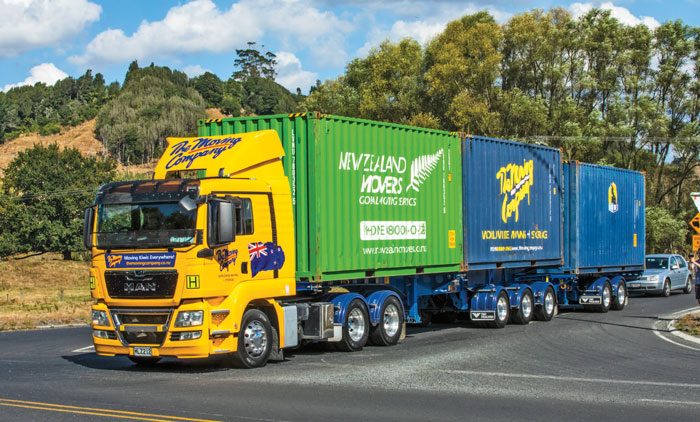
Turn and burn
Day one was up to Auckland with a load from the great southern island, and day two was cab day, with a load for people whose lives were heading in the other direction … literally. Watching the operation happen in front of you it‘s easy to see what Peter means about “keeping them fed”. Richard rolled into The Moving Company depot in the Airport Oaks estate in South Auckland at about 7am, and the big fork hoist whipped the boxes off quicker than you can say ‘undo the twist locks‘. It then took two crisp ‘cans‘ off a pristine stack in the immaculate yard and loaded them on. Richard then shot around the road to NZ Van Lines and put the tail end Charlie on. After meeting him at 7am outside the gate, we were South Island-bound at 8.10am, including a catch-up with Pete, the necessary admin, ablutions, and all the usual. Now that‘s truckin‘! Later in the morning at Taupo we jumped in the cab. Richard selected ‘D‘ for forward on the direction controller and we were off.
The TGS pulled out on the highway and the first impressions were ones of nimble and lively. The evolution of the combustion engine is a fascinating thing when you think back to say a 444 Cummins of the late 80s and compare it with this 10.5-litre 440hp engine of 2020. The 14-litre 444 was a brute of a motor with big power, and this feels so light and peppy. It‘s all about displacement obviously, not to mention the advance of injection technologies. Suffice to say the key metrics might be close, but the delivery profile entirely different. We rolled through the Bulli Point road works on the edge of Lake Taupo and on south. The MAN was direct through the corners and not willing to put up with any shenanigans by way of cab roll, feeling quite firm on its 4-air bag cab setup and big anti-roll bar. The TGS is an interesting model in the MAN line-up when you think breadth of application, all made possible by the wonders of modern automated manufacturing techniques.
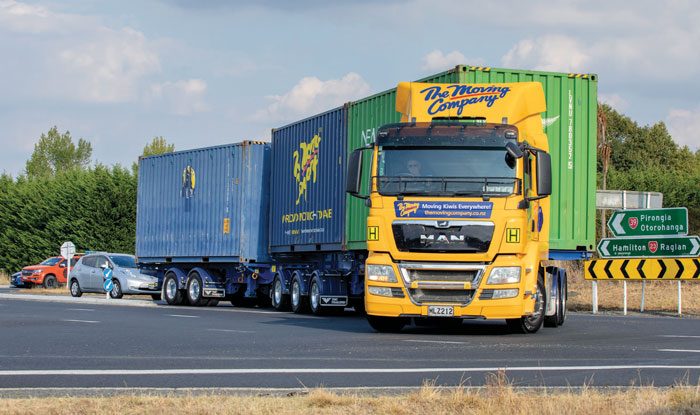
It can be a linehaul truck for the likes of The Moving Company, a concrete mixer, a high ground clearance dump truck: you name it, the TGS can do it. Richard came off a TGX 32.540 into the TGS, so he does notice the differences in terms of space, power, and the lack of a fridge, although one is available for the TGS, confirmed by Dean Hoverd, national sales manager at Penske New Zealand. “I love the MANs,” said Richard. “Absolutely love them, I think they‘re bang on.” Company owner Mark Pitcher told us his reasons for opting for the German marque. “The furniture game‘s been the home of Japanese brands in the modern era. We went for MANs on the linehaul work to make them a more attractive proposition when recruiting; comfort, a prestigious brand you might say, and also for fuel consumption and reliability.” Peter Cochrane talked about the Penske relationship.
“Penske has been good to deal with, when there have been issues there have been conversations and it‘s been sorted. We don‘t switch suppliers without really good reason; we‘d rather form relationships and work through. It‘s always cheaper in the long run.” As we rolled up toward the one-lane bridge at Tauranga Taupo, it boggled our mind to think what was being spent on things like guard rails when this fiasco has been like this for generations. Richard picked up the CB and called himself in from the north; a truck responded with his arrival from the south, due there just after we‘d crossed. “Bloody great things, CBs,” said Richard. “I wouldn‘t be without one.”
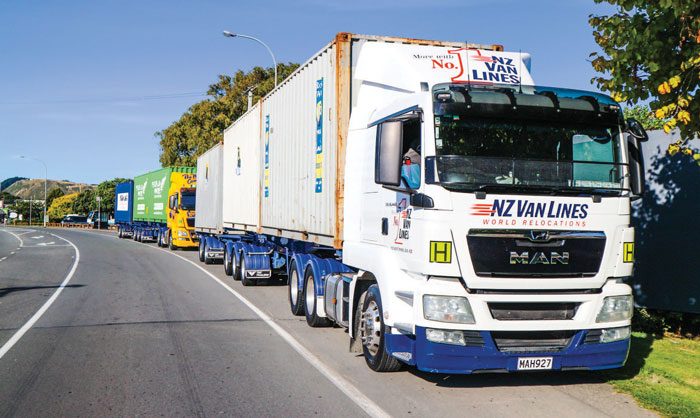
Photo: Paused at Levin, the MANs make for a spectacular sight.
Hip and groovy
Now, a trucker approaching 60 years of age, who‘s done 41 of those years in the furniture moving game driving anything and everything, when asked the AMT question, you would bet your socks would answer, ‘I drive it in manual because I prefer to be in control‘. But, no. “Nope, I stick it in auto and let it do its thing,” said Richard. “It knows what it‘s doing. The only time I switch to manual sometimes is descending a big hill loaded. The TGX I came off had the retarder and that was fantastic, it didn‘t matter, but this needs a few more rpm to get the engine brake working well enough, so I tap it down a couple. Even then I have to dab the brake in places I wouldn‘t have needed to do in the TGX; in fact I never touched the brakes in the TGX, only to bring it to a complete halt.” Even though the MAN‘s probably still got a bit of freeingup to do with only 33,000km on the clock, it was no slug, climbing the Puketerata north of the sisters at a steady 55kph in 10th at 1600rpm. Richard said the auto is actually more effective in the TGS. “I think it‘s because of the smaller motor. It‘s working that little bit harder. It‘ll take two gears on the climbs and get in the climbing gear earlier. It works really well. Yep, sometimes I miss changing gears, but it‘s modern times.”
Taking two gear jumps early with the smaller displacement burner means the D20 often climbs at the bottom end of the power curve, numbers like 1600rpm. It‘s the ideal location because the full might of torque is waiting to give that bit of extra push if it starts to slip off its perch. Chatter in the cab covered every subject known to man, all in a serene 68 to 69 decibels. Dropping onto sister number one the auxiliary brake made little difference to the ambience, and in keeping with last month‘s test, with eight modern axles and associated electronic management, 35-odd tonne is not an inducer of braking issues. “See, I just have to dab the brakes, something that wouldn‘t have happened in the TGX.” Taking the ‘A‘ approach rather than the ‘M‘ is really paying dividends for the company, with Richard saying the MANs are the most economical trucks they‘ve run. “I consistently get 2.3kpl out of it, and that‘s pretty much loaded all the time. Yes, the weights are down compared with the big fellas, but not for furniture. “The Hino I was on was an 8×4 and 3-axle, we got 1.7kpl out of that. Then I had an Iveco, and that was better at 1.8 to 1.9, but the MANs run over two, day in, day out.”
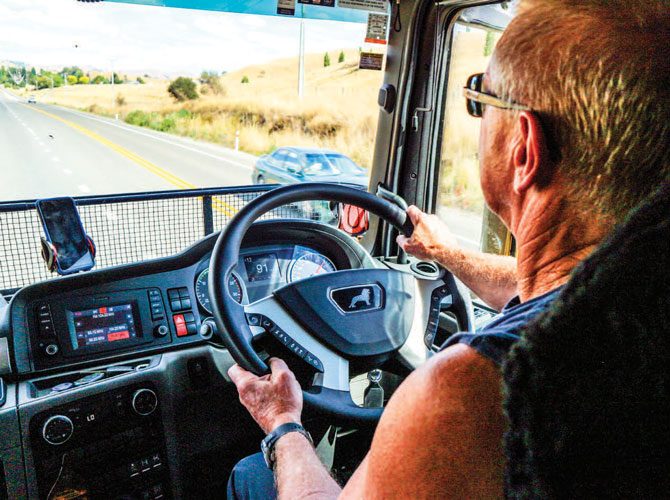
Photo: ‘A” is for attitude, ‘A‘ is for Auto. Richard Seeley, happy to let the tech do its thing and reap the fuel burn bonanza.
Space X … and S
The TGS cab is not the big condo that the TGX is. In comparable configurations (TGX L vs TGS L), engine tunnel to roof internal is 175mm lower in the TGS at 1385mm, and internal width is reduced by 198mm at 2058mm. Internal cab length is the same – 2145mm. Those wee measurements certainly add up too, and equate to a 1.43 cubic metre difference between the cabs, so you do notice the cosier confines of the TGS. “Storage is the big thing. That extra space in the TGX was largely storage. Finding somewhere to put everything when you‘re away from home most of the week. That, and the fridge. But it‘s no trouble, you get used to it and adapt; you can‘t really fault the truck, it‘s an easy place to work. If you‘d never known the TGX cab, you‘d think you were made!” What the TGS demonstrates so well is how valuable and important that area between the seats is nowadays. This truck isn‘t a pop-top and has a 260mm engine tunnel, yet it had a far greater sense of space and utility than the new Fuso did last month. What the MAN has is room defined by us as useable space.
If you can‘t make use of it, it‘s simply space. With one exception, let‘s ignore the fact we‘ve seen this cab‘s successor when talking accoutrements, and look at what it offers here and now. Munich does things its way and harking back to the blindfold thing from last month, if you knew your trucks and someone plonked you in an MAN, you‘d have it sussed in half a millisecond. It‘s like no other. A 6-gauge binnacle is also home to the telematics/trip information screen, warning lights, and some switches, with its own mini wrap to the left where the infotainment screen resides. The remaining switchgear, climate management, and direction controller are on an angled panel formed from the natural curvature as the lower cross cab fascia reaches the cockpit. It‘s unique and almost works. We say ‘almost‘, because some of the lower switchgear is a look-away proposition … at least initially.
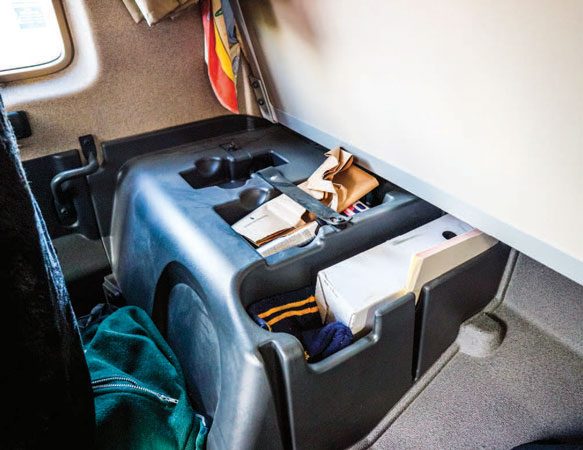
Photo: Richard keeps the bunk up by day so he can access the additional storage.
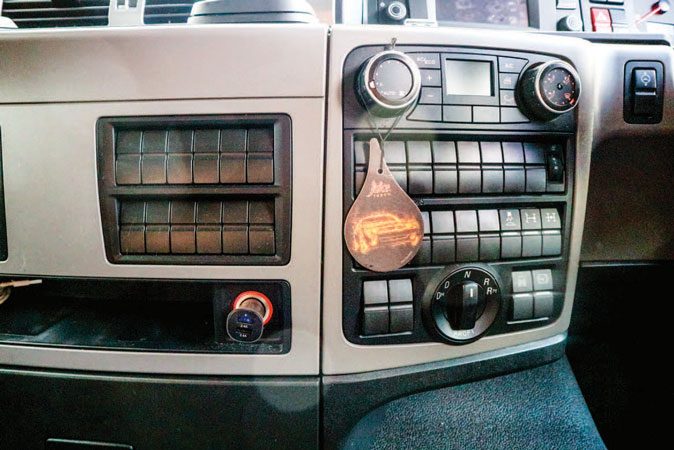
Photo: Switch gear and direction controller is on the lower wrap you might say, and quite low.
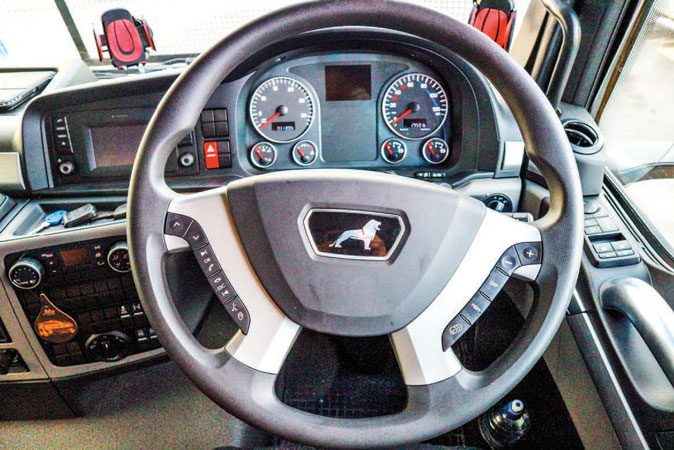
Photo: MAN binnacle is clear, efficient and contemporary, although unique.
Being a Euro it has a smart-wheel that houses the usual suspects: menu controller, phone, and cruise. Lights are on the right side of the dash, with dip, indicators and wipers on the left wand, and shifter EVBec brake on the right. Park and hand control are on a console to the driver‘s left. Now to that one exception. The big issue with the TG cab is the mirrors. They‘re plentiful, clear, give great visibility, heated and electrically adjustable. But, and it‘s a huge but, the location of the main mirror sets mean zero visibility between them and the A pillars. That vital slit truckers rely on for left-right clearance is not there, and it‘s a real arse. In the new truck, they‘ve moved the mirrors back and we can again see between mirror and A pillar. Take it from us, there was a huge sigh of relief in Spain last month when the new trucks appeared for the first time. Moving out of the driver‘s seat, there are cup holders, oddments trays, and nooks all the way along the front fascia, with one pull-out drawer. Storage overhead comprises two deep door-less stuff trays with the area right above the driver reserved for comms units and some more switch blanks. The main interior lights are built into the two structural supports for the overhead storage assembly and look quite cool, nicely spaced at third intervals across the cab.
There‘s under-bunk storage, the left-hand one accessible from the inside with the bed raised. Richard travels with the bunk up so he can make use of the utility trays under there. Fit and finish in the MAN is unfaultable. Materials are heavy vinyl, rubber, plastic, and a heavy-duty foam-type compound in a black speckled pattern. This cab‘s colour tones in black and grey, with lighter hues reserved for up top, is far more serviceable than poor Rex had to deal with in Waiotahi‘s big bopper back in May last year. We have to say we love the way the door lining envelopes the grab handle completely, allowing dash lines to flow onto door lines. Scania does it also; must be a Traton thing … classy. The doors are also where window and mirror controls lurk, as you‘d expect in 2020. Access is as simple as gets, with the truck‘s low stance and four-step entry ensuring a safe, carefree passage to the confines. In terms of the daily check department there are a couple of fluid levels – there‘s no dipstick – and it‘s all done via the front panel.
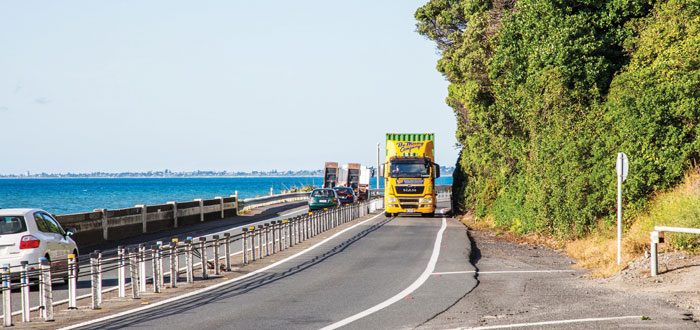
Photo: Probably the most instantly recognisable stretches of SH1 … soon to be consigned to the history books.
Boxing on
Through the North Island‘s central tracts the MAN broke the Mangawekas‘ steepest pinch at 41kph, in 9th at 1500rpm. The journey had been smooth, quiet, and comfortable sailing, the TGS bobbing along the Marton straights at 90kph with the tachometer just under 1500rpm. Further south on the crappy Horowhenua section of State Highway 1 south of Levin, the ride was on point, and soaked up the ever-changing surface commendably well. The abundance of glass and having the big roof hatch open made for a pleasant afternoon‘s motoring. The TMC trailers followed along superbly well and influenced the ride surprisingly little. Obviously a testament to Richard‘s relaxed style, but also the balance of the setup.
“Because the turnaround times are so quick it‘s easy to manage the driving hours, and that‘s great,” said Richard. “I do the occasional unload out the back if the road or street in the town is wide enough. I might have to pick up a couple of helpers at a depot and off we go. It‘s all part of it.” Richard recalled his early times in the industry. “When I started at Movements International my supervisor was a guy called Tom. He was really abrupt and just called everyone by their surnames, ‘Seeley do this, Seeley do that‘. He was the one who taught me to pack furniture and drive. The day I knew I was going to make it in this game was about four years in. A big job came up and he looked past the others in the despatch office straight at me and said, ‘Rich! You‘ve got that one okay?‘ It felt good to have that simple acknowledgement.”
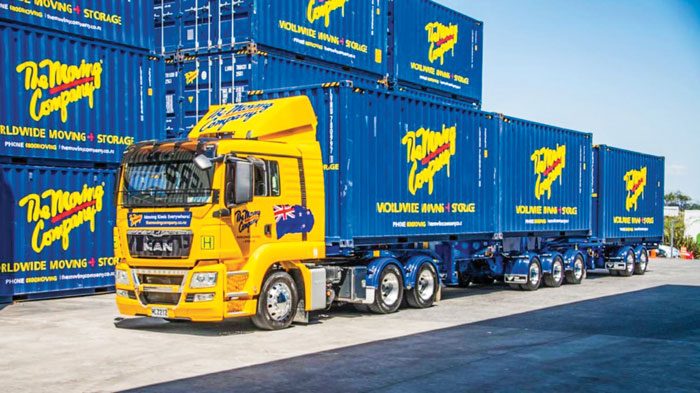
Photo: When the containers align, the result is spectacular.
Summary
We met up with Glenn in the Van Lines sister truck at Otaki and had a quick stretch of the legs. On down the line, the overnight stop was in Seaview, with Richard due to catch the ferry to Picton early the following morning. The run into Jacindaville was its usual bedlam: a congested, stop/start affair. Thank goodness for Transmission Gully‘s forecast opening at the end of the year; and a new SH1 from Peka Peka out beyond Levin can‘t come quick enough. So the question at the end of all this: has as there ever been a truck and trailer combination that‘s a better metaphor for the man at the wheel? We think not. The TGS in this guise is surely not the biggest truck in the sandpit, but it‘s tenacious, performs exceptionally well, is superbly presented and not expensive to keep alive; and on top of all that it‘s quiet, unassuming, great company, with no apparent off switch.
MORE MAIN TEST READS BELOW..
The world‘s nicest tough guy!
Born in Waimate, Richard was raised and schooled in Dunedin for the most part, and although Dad was painter and decorator, his Mum said he was a truck driver from birth. “The family lived up north in Motueka for a spell when I was very young. The local transport yard was just over the fence and Mum said if she put me on the porch in a chair with a blanket over me I was right as rain for hours. I got a trike and trailer set when I was three. All I did was ride it around and around, trying to back it into anywhere I could find.” Done with school at 16, young Seeley signed on with Movements International in Dunedin. Little did he know that in terms of career, that was pretty much it. “Furniture‘s hard, sure, but it had its appeal. The industry was regulated back then remember, and even though you spent the thick end of a day loading and unloading, you went anywhere. In those days, perishables, stock, and furniture was pretty much all there was on the Cook Strait ferries. Not like today.” So at 16 Richard spent two years learning the finer art of packing and unpacking, and at the same time darting around Dunedin in a wee Isuzu with a 10 cubic metre box body. Once he secured his heavy traffic licence aged 18, he was finally good to go, “The boss threw me the keys to a 38 cubic metre linehaul truck and said, ‘Take that to Wellington!‘ I was away.” The early linehaul days were populated with J-Model Bedfords and Isuzus. “The Bedfords had no power steering so they doubled as strength training for the furniture,” Richard bursts into hysterics. “And the bloody seat was just a squab on a piece of plywood bolted to the steel subframe! And look, now we‘re in this.” His first real gung-ho linehaul truck was a CWA Nissan Diesel with 300hp. “That was actually a bit of gear in the day. That was big power for furniture, and a nice machine.”
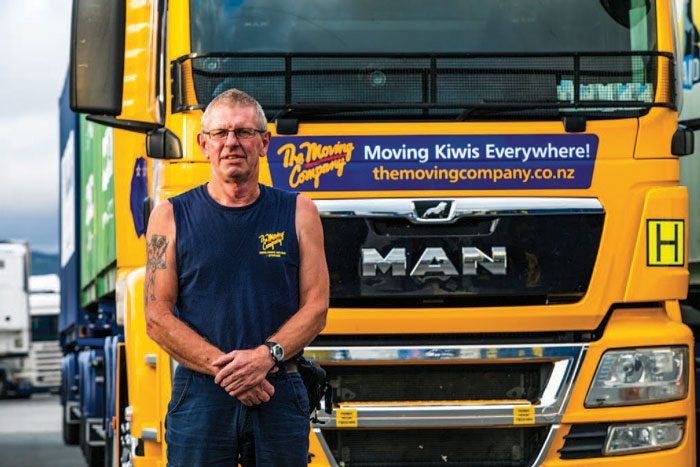
Photo: Richard Seeley has spent his life putting people in their place, in the nicest way imaginable.
Richard‘s abilities beyond the cab were quickly recognised as well, and as early as 19 years of age he was taking stints managing depots for Movements International. It‘s been a recurring theme throughout his career, but he‘s a trucker through and through and says he never settles or overly enjoys the office. “I‘ve helped out, relieving Pete [Peter Cochrane – group logistics manager at The Moving Company] in the past, and prior to this truck coming I did a seven-month spell in the operations role in Dunedin, which covers Invercargill too. I didn‘t mind it, but when they asked if I‘d be interested in driving this, I couldn‘t get in quick enough.” Interestingly Richard‘s never really left the original job he started all those years ago, having just travelled along as companies were bought and sold. He‘s been working under the Moving Company banner for 13 years and is genuine in his praise for his current employer. “It‘s a great place to work, very hard to fault.
I‘ve worked with group logistics manager Peter Cochrane for many years now and we know how the other thinks and operates. And owner Mark Pitcher is a great bloke, totally approachable, the sort of guy who‘s happy to have a beer with the boys.” Then comes the job-related questions. This man of 41 years‘ experience in one of the industry‘s toughest gigs ponders the ‘weirdest‘, ‘hardest‘, ‘most precious‘ questions put to him. “Where do I start?” laughs Richard. Then he endorses a comment ex furniture man Blair Chambers in the Eden Haulage Kenworth K200 made (New Zealand Trucking magazine October 2019). “Wellington and Dunedin are your two toughest places to load or deliver furniture for sure. In terms of precious, we shifted the Terracotta Warriors when they were out here last year. That was an interesting experience. It was all done under escort. One of our sister companies, New Zealand Van Lines, has moved the Symphony Orchestra around for decades and that‘s all in temperature-controlled trailers. “In terms of hardest move? Well, you‘d have to say one in Wellington a few years back.
The access was so small we had no hope of getting into it. We got the traffic department involved and they closed the street. We laid out cargo nets on the road and unloaded onto them, and then choppered it onto the front lawn of the house. We walked in and carried it all from the nets into the house. The cost must have been horrendous but it seemed no concern at all to the customer. “Biggest? Well, when you think the average house lot, Dad, Mum, and 2.5 kids is about 34 cube and will fit into a 20‘ container, I‘ve moved some lots that were 200 cubic.” But it‘s Richard‘s appreciation for what they‘re entrusted to do that‘s a measure of the man‘s integrity. “It‘s a job that carries huge trust. A full pack, where the family walks out of a functioning house and you walk in, pack it all and shift it; they‘re entrusting you with their lives and you have to appreciate and respect that.” Richard has two boys, Jerome and Sheldon. Jerome has just got his class 5 licence and works at the Moving Company, and Sheldon operates earthmoving machinery in the Waikato. So there you have Richard Seeley, grafter and toiler supreme.
The embodiment of the phrase ‘attitude is everything‘, because for all the tough yards he‘s put in, you‘d be hard pressed to spend a happier two days in a truck with a more positive bloke. “I love it, I just love it. I love the truck, getting around and meeting all sorts of people. I‘ve always been happy in my own company and this just suits me down to the ground. The body‘s certainly not what it was, and tells me when it‘s had enough.” After 41 years in the furniture game … can you blame it? But you won‘t stop him as long as boxes have to be places, and there‘s an MAN to get them there!
Origins of the Lion
The profile of a male lion in the central part of the MAN logo is synonymous with the brand. But how did old Leo find his way there? What‘s his story? Well, turns out he arrived via acquisition, his name is Heinrich not Leo, and his association with MAN specifically, doesn‘t go as far back as you might think. The Lion‘s profile was a logo of Büssing AG, a company founded by Heinrich Büssing and his two sons in 1903 under the name … wait for it … Henrich Büssing, specialist factory for motorised trucks, motorised buses/ coaches and engines, Braunschweig. Mr Büssing was an incredible engineer and innovator, and some of today‘s base concepts around trucks and buses rest with his cleverness; things like 3-axle double drive chassis. In 1967 MAN began a co-supply arrangement with Büssing AG that led to a full acquisition process which reached a conclusion in 1972. In recognition of the significant role Heinrich Büssing played in the evolution of the German and global automotive industry, MAN adopted the Büssing Lion as part of its logo.
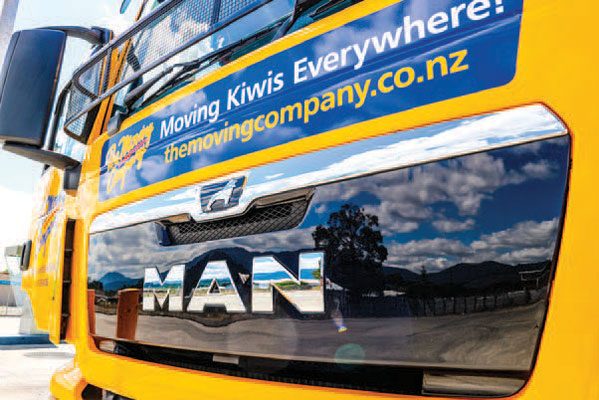
A clear Pitcher
Being around a business and hearing the people interact gives you a good feel for culture. Hearing them convey the culture to you enthusiastically impresses more, and then you meet the epicentre himself. Ebullient, charismatic, a total believer in his brands, people, and goals, Mark Pitcher is walking Berocca. And he‘s old school. It‘s about presentation, image: if he says ‘get that truck cleaned‘, it‘s cleaned. The yards, offices, grounds, they‘re sharp. He started on ‘the floor‘ as he puts it, just like Richard Seeley, as a 16-year-old stowing furniture at … you guessed it, Movements International. That means he‘s as comfortable walking out in the yard chatting to the troops as he is in the boardroom, more so probably. Branch depots have a cook-up once a month before work. We witnessed one on a day we were there. A big barbeque, eggs for Africa, bacon, she was all on. He knows what it‘s like to be at the coalface. It‘s often the little things that return most on the spend. As group logistics manager Peter Cochrane says, “This is still an industry where stuff is lifted manually. There is no other way.” Mark has big plans and he knows the direction he wants his brands to go in. He has a great feel for ‘his‘ industry, with that rare blend of upbeat no-nonsense th
Read more
The right man for the job
0 Comments29 Minutes
Legendary ambition
0 Comments36 Minutes
Hard Fought!
0 Comments40 Minutes
Postal Trifecta
0 Comments29 Minutes





